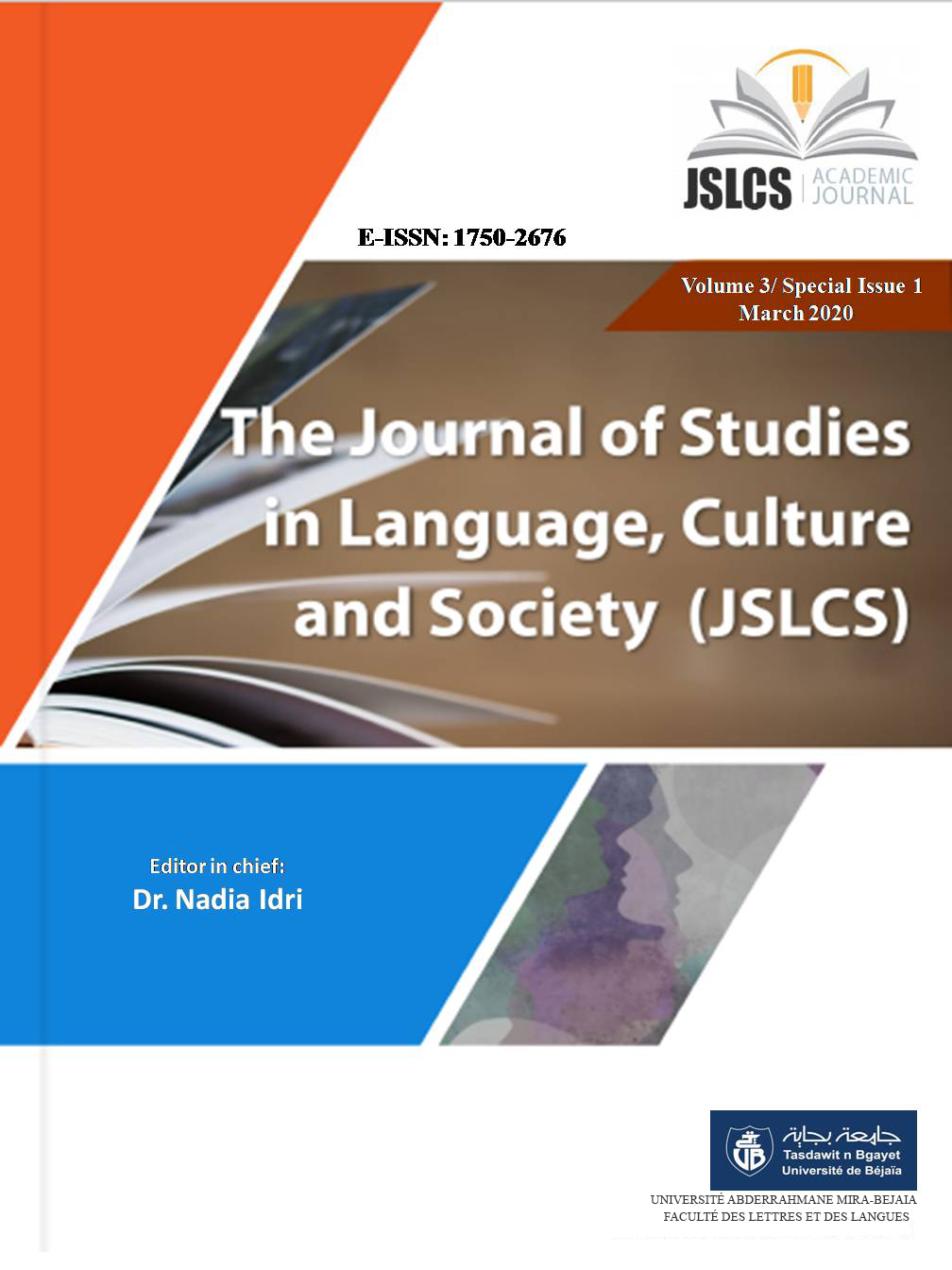Multimedia Related Vocabulary Learning Strategies among English as a Foreign Language Algerian Students
Keywords:
Multimedia, VLS, vocabulary learning strategies, vocabulary sizeAbstract
The focus in the present paper is on the evolution of students' behaviour in terms of Vocabulary Learning Strategies use from Year 1 to Year 3, with special focus on the type of strategies that might be conductive to larger vocabulary size. The study is undertaken with 184 EFL undergraduate students at the University of Algiers 2, and the data collection instruments comprise: the Vocabulary Size Test (VST) (Nation 2007), VLS Questionnaire (Schmitt 1997) and a general vocabulary learning open questionnaire. Findings reveal that the whole population has similar preferences for Determination and Metacognitive Strategies, while Social Strategies are the least frequently used. Besides, analysis of correlations between variables does not demonstrate any significant impact of VLS use on vocabulary size growth, except for the low-intermediate freshers for whom Metacognitive Strategies involving the use of the Internet to search for information or to communicate seem to be significantly correlated to their vocabulary size. These findings have interesting implications for the classroom as they stress the importance of integrating explicit vocabulary instruction as well as strategy training to reinforce the students’ vocabulary knowledge and build up stronger learners’ autonomy, and it shows the potential support of multimedia related strategies in developing this knowledge.
References
Ahmed, M. (1989). Vocabulary learning strategies. In P. Meara (Ed.), British Studies in Applied Linguistics, 4, 3-14. London: British Association of Applied Linguistics/Center for Language Teaching.
Chan, A. Y. W. (2012). Cantonese ESL learners’ use of grammatical information in a monolingual dictionary for determining the correct use of a target word. International Journal of Lexicography, 25(1): 68-94.
Cohen, A. (1990). Language learning: Insight for Learners, Teachers, and Researchers. Boston: Heinle & Heinle.
Cohen, A. D. (1998). Strategies in Learning and Using a Second Language. London/ New York: Longman.
Fan, M. Y. (2003). Frequency of use, perceived usefulness, and actual usefulness of second language vocabulary strategies: A study of Hong Kong learners. The Modern Language Journal, 87(2): 222-241.
Fraser, C. A. (1999). Lexical processing strategy use and vocabulary learning through reading. Studies in Second Language Acquisition, 21(2): 225-241.
Gu, Y & Johnson, R. K. (1996). Vocabulary learning strategies and language learning outcomes. Language Learning, 46(4): 643-679.
Gu, Y. (2010). Learning Strategies for Vocabulary Development. Reflections on English Language Teaching.9(2): 105-118. Retrieved from: www.researchgate.net/publication/272494641
Hamzah, S. G., Kafipour, R. & Abdullah, S. K. (2009). Vocabulary learning strategies of Iranian undergraduate EFL students and its relation to their vocabulary size. European Journal of Social Sciences, 11(1): 39-50.
Hulstijn, J. H. (1997). Mnemonic methods in foreign language vocabulary learning: Theoretical considerations and pedagogical implications. In J. Coady& T. Huckin (Eds.), Second Language Vocabulary Acquisition: A Rationale for Pedagogy (pp: 203-224). Cambridge: CUP.
Lee, J. (2011). Size matters: Early vocabulary as a predictor of language and literacy competence. Applied Psycholinguistics, 32: 69–92.
Mahmoud, A.M.A &Yalcin Arslan, F. (2017). The Relationship between Iraqi EFL learners’ vocabulary learning strategies use and their receptive vocabulary size. Arab World English Journal (AWEJ), 8(4): 303-317. Retrieved from: https://dx.doi.org/10.24093/awej/vol8no4.21
Meara, P. (1995). The importance of an early emphasis on L2 vocabulary. JALT, 19: 8-11.
Milton, J. (2009). Measuring Second Language Vocabulary Acquisition. Bristol, UK: Multilingual Matters.
Nation, P. (1990). Teaching and Learning Vocabulary. Boston, MA: Heinle & Heinle.
Nation, P. (2001). Learning Vocabulary in Another Language. Cambridge: CUP
Nation, P & Beglar, D. (2007). A vocabulary size test. The Language Teacher, 31(7): 9-13.
O’Malley, J & Chamot, A. (1990). Learning Strategies in Second Language Acquisition. Cambridge: CUP.
Oxford, R. L. (1989). Use of language learning strategies: A synthesis of studies with implications for strategy training. System, 17(2): 235-247.
Oxford, R. L. (1990). Language Learning Strategies: What Every Teacher Should Know. New York: Heinle and Heinle Publishers.
Rubin, J (1987). Learner strategies: Theoretical assumptions, research history and typology. In A. Wenden and J. Rubin (eds), Learner Strategies in Language Learning, (pp: 15–30). NewYork :Prentice Hall.
Sanaoui, R. (1995). Adult learners’ approaches to learning vocabulary in second languages. The Modern Language Journal, 79(1): 15-28.
Schmitt, N & McCarthy, M. (1997). Vocabulary: Description, Acquisition and Pedagogy. Cambridge: CUP
Schmitt, N. (1997a). Vocabulary learning strategies. In N. Schmitt & M. McCarthy (Eds.), Vocabulary: Description, Acquisition and Pedagogy (pp. 199-227). Cambridge: CUP.
Schmitt, N. (2000). Vocabulary acquisition. In N, Schmitt (ed). Vocabulary in Language Teaching, ed. N. Schmitt, (pp:116–41). Cambridge: Cambridge Language Education.
Talbi-Hassani, A (2019). English Vocabulary Size Growth and Vocabulary Learning Strategies: A Study Across the Three English Degree Years at the University of Algiers Unpublished (ongoing) doctoral dissertation.University of Algiers 2, Algiers, Algeria.
Tanyer, S &Ozturk, Y. (2014). Pre-service English Teachers‟ Vocabulary Learning Strategy Use and Vocabulary Size: A Cross-sectional Evaluation. Journal of Language Teaching and Research, 5(1): 37-45
Tseng, W.T & Schmitt, N. (2008). Toward a model of motivated vocabulary learning: A structural equation modelling approach. Language Learning, 58(2): 357-400.
Ur, P. (2002). A Course in Language Teaching: Practice and Theory. UK: CUP.
Wenden, A. (1998). Metacognitive knowledge and language learning. Applied Linguistics, 19(4): 515-537.








